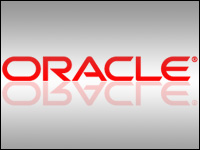
I don’t know how much Oracle spends on research and development each year. I know the biggest piece is being spent on CRM these days, something that warms my heart. The R&D number is in the billions of dollars, and though I cannot confirm it easily, the number seven seems about it. Judging by the turnout and the number and quality of sessions available at Oracle OpenWorld in San Francisco this week, the billions buy a lot, and they are well-spent.
As usual, the CRM team has a lot to talk about. Here are some highlights:
Only a year after Oracle CEO Larry Ellison dismissed cloud computing, Oracle is delivering major cloud functionality. The company announced a hardware and software solution involving its Exadata storage architecture and Exalogic fault tolerant servers at the heart of its cloud strategy. Oracle is making a play to host major corporate applications with an architecture clearly designed for this market. It offers companies the choice of managing their own clouds or letting Oracle provide all the services.
The company says that one huge benefit this cloud approach offers is elasticity — as in, on-demand additional storage and computing resources that do not require long ramp-up periods. All this is true, but it tends to reduce cloud computing to a low common denominator, namely infrastructure as a service. There’s no getting around the fact that many corporations want just this much cloud computing, and as a result it is hard to see how Oracle could lose money on the proposition.
Clinching the Sale
It was good to see that some of the CRM product directions are based on the same market assumptions I have been discussing for the last couple of years. Though we might disagree about the drivers for the market shifts, the practical effect is that demand is down and could stay that way for some time. New product categories are forming more slowly than we’ve seen in the past, and these things affect how and what companies sell.
In these circumstances, it is good that Oracle is putting new emphasis on selling. Case in point is the Sales Performance Suite, developed in Fusion that is penetrating both Siebel CRM and Oracle CRM On-Demand. Fusion has analytics support built i,n and analytics permeate applications based on the platform. This results in some interesting applications for sales planning, territory planning, predictive analysis and one of my favorites, white space analytics.
In the future that I see, selling will look a lot more like retail, pharmaceuticals and consumer goods do now — established vendors selling into known customer bases and less new ground to cover. Vendors will necessarily need applications that can help them pinpoint how and when to sell upgrades or to make new offers to existing customers. That’s where analytics will shine, and it points out the need for better social tools that capture the raw data these analytic engines will use.
The goal of Oracle’s vision of sales performance is to help organizations better ensure adequate opportunity across all sales territories and with better coverage achieve better results overall. On the other side of the coin, new or improved applications designed to help vendors better understand customer lifetime value come with more social media support.
As Anthony Lye explained in one of his team’s presentations, customer lifetime value used to be measured only by the amount of revenue a vendor could expect from a customer. Now, though, with the addition of better analytics and social tools, customer lifetime value is being extended to include the value of a person’s social network and the likelihood that a person will tell his or her network about a product or service. It’s viral marketing on a grand scale, and one term the company is using — “Social Activity Stream” — should become popular.
Cross Channel CRM
Other revelations might have been less dramatic but more reassuring. For instance, with regard to Fusion and Fusion applications, more than once I was told that Fusion is positioned as a tool for incremental application improvement, not wholesale application replacement, though that’s certainly possible too.
This means the brands that Oracle bought several years ago are not slated to disappear under a tsunami of Fusion applications; over time Fusion will be used by each product set to improve it.
One of my favorite ideas is Cross Channel CRM. Simply put, it is what makes it possible to surf the Web, talk to a salesperson, make a purchase online and pick it up at a nearby store. The logistics involved in passing all the data around to the many different channels are significant and an important direction for Oracle.
Then there’s mobility, which isn’t exactly new, but the concept is being enlarged. Oracle expects that sales of handheld devices will exceed conventional computers in the near future and that they — including tablets like the iPad — will become the primary CRM device. Take a minute to let that sink in.
It doesn’t mean the PC industry is in trouble, but it does suggest the increased importance of mobility. In a world with high transportation costs (and regular is US$3.59 down the street form me right now), every change of location is a cost consideration, and saving transportation costs is a key future direction. For those reasons alone, mobile devices fueled by data and intelligence from headquarters will be important for maintaining a competitive edge. These are some of the same reasons that territory planning, lead optimization and analyzing white space become more important too. All help a company’s customer outreach to be more efficient, and the return on sales investment has always been important, and that won’t change.
Not all of the R&D budget goes directly into software development. I was impressed to hear Anthony Lye’s travel statistics for the last year — 240,000 air miles, 60 cities, 40 countries and more. He is not alone; the rest of the CRM team has similarly impressive numbers, which Lye said are accumulated visiting customers and listening to their needs as a routine part of the product development process. As it should be.
All in all, the picture I get from OpenWorld is Oracle’s belief that markets are changing, but also that the recession is ending and it is time to focus a bit more on selling. In the last couple of years, our industry has focused a lot on customer service, and while that’s important, it’s also a defensive posture. Selling means playing offense, and the change is welcome.
Denis Pombriant is the managing principal of the Beagle Research Group, a CRM market research firm and consultancy. Pombriant’s research concentrates on evolving product ideas and emerging companies in the sales, marketing and call center disciplines. His research is freely distributed through a blog and Web site. He is the author of Hello, Ladies! Dispatches from the Social CRM Frontier and can be reached at [email protected].























































Social CRM
See all Social CRM